Fishing Reel Line Roller: Essential Components Explained
Fishing Reel Line Roller: Essential Components Explained
September 4, 2024

Fishing reel line rollers are crucial parts
Fishing reel line roller is crucial components that significantly enhance the performance and longevity of fishing reels. These line rollers, strategically positioned near the bail arm, ensure that the fishing line moves smoothly during both casting and retrieval. Constructed from high-quality materials like stainless steel or ceramic, fishing reel line rollers are designed to reduce friction, preventing wear and tear on the line.
This is especially important when using braided lines, which are prone to twisting and tangling. High-end reel line rollers often incorporate fishing reel ball bearings, providing an extra layer of smoothness and precision. Regular maintenance of these rollers, including cleaning and lubrication, is essential to keep them functioning optimally.
By minimizing line twists and ensuring a smoother cast, they enhance the overall angling experience, allowing anglers to focus on their technique and the thrill of the catch. Understanding the importance of fishing line rollers can help anglers make informed decisions when selecting and maintaining their equipment, ultimately leading to better performance and greater success on the water.
Introduction
Fishing reel line rollers are often unsung heroes of angling gear, quietly performing a crucial role in ensuring smooth casting and retrieval.
This article delves into what they are, their functions and types, and why they’re indispensable for anglers of all levels.
What is a fishing reel line roller?
A fishing reel line roller is a small yet integral part of the reel mechanism, typically located within the bail assembly. Its primary function is to guide the fishing line onto the spool during casting and retrieval. By rotating smoothly, the line roller helps distribute the line evenly, minimizing friction and preventing line twists.
Functions and Importance
The fundamental role of a fishing reel line roller is to enhance casting distance and accuracy by facilitating smooth line management. By reducing friction and preventing line tangles, these rollers contribute to a more efficient fishing experience. They also help extend the lifespan of fishing lines by minimizing wear and tear during use.
Types of Fishing Reel Line Roller
Ball Bearing Rollers: These rollers use ball bearings to achieve smooth rotation, offering excellent durability and performance. They are commonly found in high-quality spinning reels designed for precision and reliability. So smooth ball bearings are available in fishing reels.
Ceramic Rollers: Known for their corrosion resistance and low friction properties, ceramic rollers are ideal for saltwater fishing environments. They help protect the fishing line from abrasion and ensure smooth operation even in harsh conditions.
Titanium Rollers: Titanium rollers combine lightweight construction with exceptional strength and corrosion resistance. They are favored for their durability and suitability for both freshwater and saltwater fishing applications.
Materials Used in Line Rollers
Line rollers are crafted from various materials to meet different performance needs.
- Stainless steel: is durable and resistant to corrosion.
- Aluminum: lightweight and corrosion-resistant, suitable for freshwater fishing.
- Ceramic: Provides smooth operation and protection against saltwater corrosion.
- Titanium: combines strength with lightweight properties, making it ideal for high-performance reels.
Factors to Consider When Choosing Line Roller
When selecting a fishing reel line roller, consider the following factors to ensure compatibility and performance:
- Reel Type: Different reel designs may require specific types of line rollers.
- Fishing Environment: Choose rollers that can withstand the conditions where you fish, whether freshwater or saltwater.
- Line Compatibility: Ensure the roller is suitable for the type and weight of fishing line you use.
- Maintenance Requirements: Consider the ease of maintenance and longevity of the roller material.
Maintenance Tips for Line Rollers
To maintain optimal performance and longevity:
- Regular Cleaning: Remove debris and salt residue by cleaning the rollers after each fishing trip.
- Inspection: Check for signs of wear or damage, and replace or repair as needed.
- Lubrication:For smooth operation and corrosion prevention, use appropriate lubricants on moving parts.
Here we recommend one post on how to spool a spinning reel for your reference.
Summary
fishing reel line rollers may seem like small components, but their impact on fishing efficiency and enjoyment is significant. Understanding their functions, types, and maintenance requirements can help anglers make informed choices when selecting fishing reels.
Whether you’re casting for bass in a local pond or battling offshore monsters, investing in quality line rollers ensures smoother, more productive fishing experiences.
Fishing reel line rollers play a crucial role in ensuring smooth and efficient line retrieval. Positioned at the base of the bail arm, the line roller guides the fishing line evenly onto the spool as you reel in. This prevents line twists and tangles, which can cause frustrating snags and decrease casting distance. Quality line rollers are often equipped with bearings to reduce friction, ensuring that the line flows smoothly, especially when under tension from a catch.
Without a properly functioning line roller, your fishing experience can be hampered by frequent line issues, leading to missed opportunities and reduced performance. Regular maintenance, such as cleaning and lubricating the roller, helps extend its lifespan and maintain optimal performance. For anglers who prioritize smooth, hassle-free fishing, investing in a reel with a high-quality line roller is essential. A well-maintained line roller enhances both durability and fishing success.



















